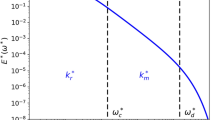Abstract
In this work, we investigate a resolution evaluation criterion based on the ratio between turbulent length-scales and grid spacing within the context of dynamic resolution evaluation in hybrid LES/RANS simulations. A modified version of the commonly used length-scale criterion is adopted. The modified length-scale criterion is evaluated for a plane channel flow and compared to the criterion based on two-point correlations. Simulation results show qualitative agreement between the two criteria and physical predictions from both resolution indicators. These observations are confirmed by simulations of flows over periodic hills. It is further demonstrated that the length-scale based criterion is relatively less sensitive on variation of model parameters compared to criteria based on resolved percentage of turbulent quantities. The improved resolution criterion is applied in a dual-mesh hybrid LES/RANS solver. Numerical simulations with the hybrid solver suggest that the interactions between the length-scale resolution indicator and the solution are moderate, and that favorable comparisons with benchmark results are obtained. In summary, we demonstrate that the modified length-scale based resolution indicator performs satisfactorily in both pure LES and hybrid simulations. Therefore, it is selected as a promising candidate to provide reliable predictions of resolution adequacy for individual cells in hybrid LES/RANS simulations.
Similar content being viewed by others
References
Chapman, D.R.: Computational aerodynamics: Development and outlook. AIAA J. 17, 1293–313 (1979)
Xiao, H., Jenny, P.: A consistent dual-mesh framework for hybrid LES/RANSmodeling. J. Comput. Phys. 231(4), 1848–1865 (2012)
Gant, S.E.: Reliability issues of LES-related approaches in an industrial context. Flow Turbul. Combust. 84, 325–335 (2010)
Celik, I.B., Cehreli, Z.N., Yavuz, I.: Index of resolution quality for large eddy simulations. J. Fluids Eng. 949–958 (2005)
Klein, M.: An attempt to assess the quality of large eddy simulations in the context of implicit filtering. Flow Turbul. Comathbfust. 75, 131–147 (2005)
Grötzbach, G.: Revisiting the resolution requirements for turbulence simulations in nuclear heat transfer. Nucl. Eng. Des. 241(11), 4347–4632 (2011)
Sagaut, P.: Large Eddy Simulations for Incompressible Flows: An Introduction. Springer (2006)
Geurts, B.J., Fröhlich, J.: A framework for predicting accuracy limitations in large eddy simulation. Phys. Fluids 14, 41–44 (2002)
Davidson, L.: Large eddy simulations: How to evaluate resolution.Int. J. Heat Fluid Flow 30, 1016–1025 (2009)
Davidson, L.: How to estimate the resolution of an LES of recirculating flow. In: Quality and Reliability of Large-Eddy Simulations II, pp. 269–286. Springer (2010)
Pope, S.B.: Turbulent Flows. Cambridge University Press, Cambridge (2000)
Breuer, M., Jaffrezic, B., Arora, K.: Hybrid LES–RANS technique based on a one-equation near-wall model.Theor. Comput. Fluid Dynamics 22, 157–187 (2008)
OpenCFD Ltd.: The open source CFD toolbox. www.openfoam.com (2011)
Xiao, H., Wild, M., Jenny, P.: Preliminary evaluation and applications of a consistent hybrid LES–RANS method. In: Fu, S., et al. (eds.) Progress in Hybrid RANSLES Modeling, NNFM (117), pp. 91–100. Springer (2011)
Issa, R.I.: Solution of the implicitly discretised fluid flow equations by operator-splitting. J. Comput. Phys. 62, 40–65 (1986)
Rhie, C.M., Chow, W.L.: A numerical study of the turbulent flow past an isolated airfoil with trailing edge separation. AIAA 21(11), 1525–1532 (1983)
Yoshizawa, A., Horiuti, K.: A statistically-derived subgrid-scale kinetic energy model for the large-eddy-simulation of turbulent flows. J. Phys. Soc. Jpn. 54, 2834–2839 (1985)
Jakirlić, S., Kniesner, B., Kadavelil, G., Gnirß, M.: Experimental and computational investigations of flow and mixing in a single-annular comathbfustor configuration. Flow Turbul. Comathbfust. 83, 425–448 (2009)
Moin, P., Kim, J.: Numerical investigation of turbulent channel flow. J. Fluid Mech. 118, 341–377 (1982)
Saric, S., Jakirlic, S., Breuer, M., Jaffrezic, B., Deng, G., Chikhaoui, O., Fröhlich, J., von Terzi, D., Manhart, M., Peller, N.: Evaluation of detached eddy simulations for predicting the flow over periodic hills. In: ESAIM: Proceedings, vol. 16, pp. 133–145. doi:10.1051/proc:2007016 (2007)
Temmerman, L., Leschziner, M.A.: Flow over 2D periodic hills. http://cfd.mace.manchester.ac.uk/twiki/bin/view/CfdTm/TestCase014
Addad, Y., Laurence, D., Talotte, C., Jacob, M.C.: Large eddy simulation of a forward-backward facing step for acoustic source identification. Int. J. Heat Fluid Flow 24(4), 562–571 (2003)
Breuer, M., Peller, N., Rapp, C., Manhart, M.: Flow over periodic hills: Numerical and experimental study in a wide range of Reynolds numbers. Comput. Fluids 38(2), 433–457 (2009)
Durbin, P.A.: A Reynolds stress model for near-wall turbulence. J. Fluid Mech. 249, 465–498 (1993)
Nicoud, F., Ducros, F.: Subgrid-scale stress modelling based on the square of the velocity gradient tensor. Flow Turbul. Comathbfust. 62, 183–200 (1999)
Kim, J., Moin, P., Moser, R.: Turbulence statistics in fully developed channel flow at low Reynolds number. J Fluid Mech. 177, 133–166 (1987)
Author information
Authors and Affiliations
Corresponding authors
Rights and permissions
About this article
Cite this article
Xiao, H., Wang, J. & Jenny, P. Dynamic Evaluation of Mesh Resolution and Its Application in Hybrid LES/RANS Methods. Flow Turbulence Combust 93, 141–170 (2014). https://doi.org/10.1007/s10494-014-9541-9
Received:
Accepted:
Published:
Issue Date:
DOI: https://doi.org/10.1007/s10494-014-9541-9




